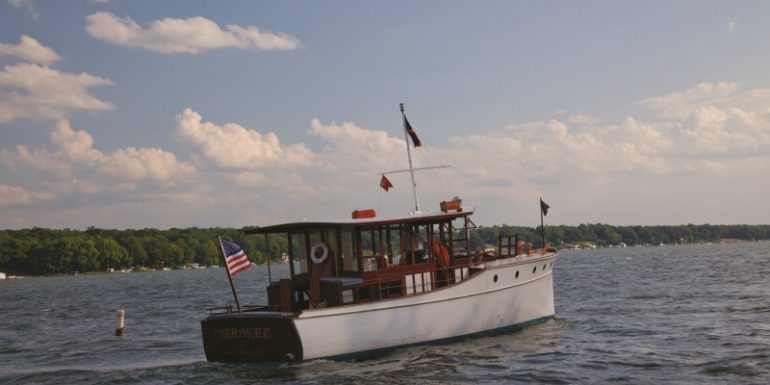Story by Anne Morrissy | Photography by Clint Farlinger
A few years ago, Delavan resident Patrick Maher was browsing antique and wooden boat websites when he came across a listing he couldn’t resist. A man named David Young in nearby Elkhorn was selling a 45-foot day cruiser yacht from 1924 called the Cherokee. Maher knew he had to have it despite the condition of the boat, which had been out of the water for at least seven seasons. “David had hoped to restore it and take it down the Mississippi, but the boat challenged him too much.” said Maher. “I had admired the boat from afar for many years because it was parked at his residence.”
Maher grew up around wooden boats living in Fontana’s Glenwood Springs during the summers. “My father had six different boats, because if you didn’t have a boat on your buoys [in Glenwood Springs], you lost your buoy,” Maher remembered. “It was kind of a full-time job in the summers to take care of them all.” He started at age eight sanding boats in Abbey Harbor. As an adult, he inherited his father’s passion for wooden boats, and has owned several vintage ChrisCrafts.
When he found the listing for the Cherokee, Maher’s brother Dan, a certified captain, encouraged him to take the plunge and buy the boat. “Dan was really supportive and helpful throughout the process,” Maher said. Previous owners had completed an extensive renovation of the Cherokee, but seven years out of the water had taken a toll. “You could see through the hull when I acquired it,” he said.
A SEAWORTHY RESTORATION
Two years ago, Maher began the cosmetic restoration process. “The first season, I just did a paint job to get her in the water and see what we had. Then last year, I put an Imron finish on it. That’s a paint that they use on aircraft, so it’s a super hard finish. Then I worked on all the bright work on the boat, like the varnished mahogany areas — I touched all of that at least twice. It’s an ongoing project forever.” Maher estimates that he spends about 20 hours a week in the summer working on the restoration and upkeep of the Cherokee, and drives the boat only about four hours a week.
He’s also been trying to research the history of the Cherokee — which has had several names over the course of its existence, including the Nandorcliff, the Puffin and the Riffian — but has had trouble finding documentation. His preliminary research indicates that the boat may at one time have been acquired by someone in the Heinz family, of ketchup- empire fame.
Here’s what he knows for sure, courtesy of an original plaque on the yacht: the Cherokee was built by a company called Consolidated Shipbuilding at their shipyard in Morris Heights, New Jersey in 1924 and initially ran on a top-of-the-line Speedway engine. (The engine has since been replaced by a Caterpillar diesel engine.) This information alone paints a vivid picture of the era and setting into which the Cherokee emerged.
THE GOLDEN ERA OF WATER COMMUTING
Since the Industrial Revolution, America has been a country of commuters. Today, the average commute is 130 minutes a week, and 92 percent of commuters travel by car; only 5 percent use public transportation.
But in 1920, automobiles were a new invention that had yet to be optimized for long journeys or frequent use; they were slow moving, they broke down often and they were hot and uncomfortable to ride in. Trains presented problems as well; frequent strikes interrupted service and high snow drifts could strand passengers in the winter. Manhattan, being an island, offered an alternative option for commuters: motorboats. And for wealthy people living in suburbs outside of New York City who commuted to an office in Manhattan, this led to a golden era of commuting by yacht in the 1920s.
An article in the now defunct New York Tribune dated June 13, 1920, announced:
“It is declared by motor boat builders and persons owning motorboats that the automobile is all right and will do in winter months, but that if you live on the Sound, or even near enough to it to get to your boat in time, or if you live up state, either along the Sound or on the Hudson, you will be entirely behind the times this year if you fail to join the throngs of water commuters within the next few weeks.”
The article goes on to claim that commuting downtown from Harlem, the Bronx, Long Island or towns further upriver or further north on the Sound could take several hours by automobile, but the trip was significantly shortened by boat travel. As a result, there were “at least 100 men and women” commuting to New York City this way at the time the article was written.
The article notes in bold letters that, “Girls are doing it too,” and highlights the story of a young woman on Long Island who traded in the new automobile her father gave her as a Christmas present for a motorboat. “I have no dust or dirt and no trouble with bad tires,” she is quoted as saying, and describes the scenery: “It’s so beautiful. There isn’t a bit of scenery in Europe so grand as that which I see each evening as I ride around the Sound in my boat, watching the sun sink over the hills and trees.”
LUXURY YACHTS FULL OF THE LATEST AMENITIES
The Roaring Twenties made millionaires out of ordinary citizens, and the luxury market rose up to meet the new demand. Consolidated Shipbuilding out of Morris Heights, New Jersey, had recently resumed its commercial operations after building destroyers and minesweepers for use by the US Navy during WWI. When the war ended, they converted their production line to the newly popular day cruisers and speedboats. They quickly established themselves as one of the top wooden yacht builders in the east.
The lushly appointed commuter yachts featured sleeping cabins, kitchens, and pilot houses for protection from the elements. They often came outfitted in mahogany, rosewood and plate glass and were stocked with the latest electrical appliances, including phonographs, toilets, iceboxes and electric lights.
To purchase one of the new state-of-the-art yachts, a customer would hire a yacht agent. An agent knew the latest amenities and trends, and published a catalog of the season’s newest models from a variety of boat builders. Once he established a customer’s needs, he would present them with several options and often escort them to a harbor to view the boat. He would arrange for the sale or rental between the buyer and the boat company.
One such yacht agent in Manhattan was Gerald W. Ford, who started his Manhattan yacht agency around 1917. By the time of the 1920s water commuting fad, he had established an office on 42nd Street in Midtown Manhattan, and he lived in the water commutable suburb of New Rochelle, NY. It is reasonable to assume that he was one of the boat commuters mentioned in the New York Tribune article. At the time, he owned a 1908 37-foot yacht called the Broadbill which he likely used for the roughly 1.5hour commute.
The son of Irish immigrants, Ford eventually patented the name G.W. Ford Yacht Agency and moved his office to the Chrysler building, where it remained through the 1950s. He appears to have been a lifelong boat enthusiast and collector; later he also acquired a 12-meter sailboat called the Nyala.
According to Maher, the name Gerald W. Ford also appears as a later owner on the title of the Cherokee. There is no way to prove it is the same person, but it is not difficult to imagine yacht agent Ford eventually taking possession of the wooden yacht.
MAHER-ATIME CHARTERS
Prior to its arrival in Walworth County, the Cherokee had found its way to Old Mystic Seaport, CT, site of the Mystic Seaport Museum of America and the Sea. Now it is a favorite sight on Delavan Lake in the summers. “People go nuts over it,” Maher said. “We have people run out of their homes to take pictures of it, and people in boats who come up alongside to honk their horns.”
Maher makes the yacht available for charters through maheratimecharters.com, his website and Facebook page. The yacht has been used for wedding photos and memorial services and everything in between. As a member of the Delavan Lake Yacht Club, Maher also uses it as a spectator boat for races and regattas.
Ultimately he considers the Cherokee a tribute to his brother Dan, who convinced him to purchase the boat; sadly, Dan passed away in 2012. “I view it as sort of a tribute to him, and his expertise in captaining,” Maher said. “He really helped out in the beginning, and kept me grounded as I was tackling the project, kept me sane and calm.”
From the yacht commuting era of the 1920s to the leisure boating of today, the Cherokee has survived endless changing tastes and harsh conditions, which is a testament to the classic construction of Consolidated Shipbuilders. The 2014 season marks the Cherokee’s 90th. Thanks to Maher’s diligent work, it’s a milestone the yacht will celebrate in the water, a Delavan Lake icon.





